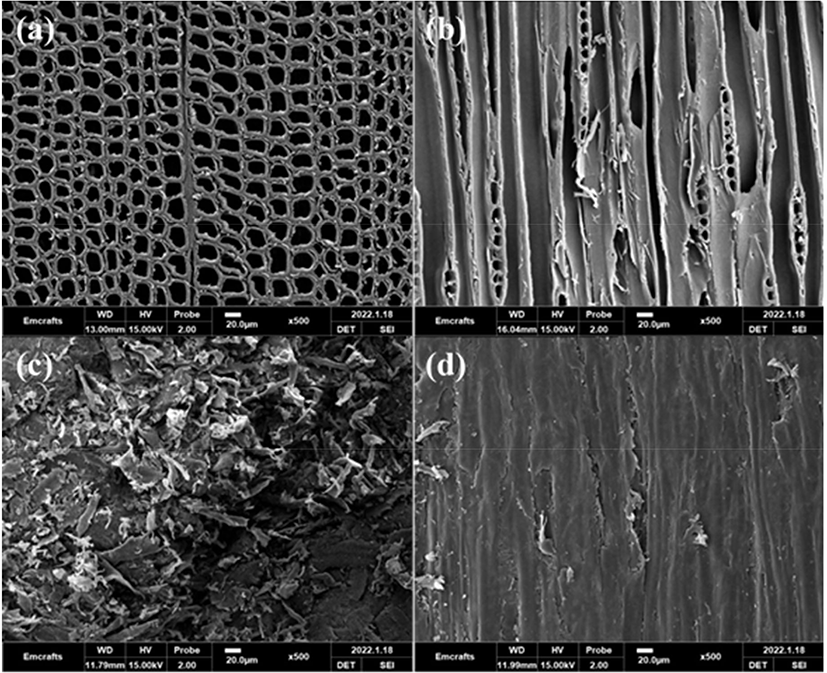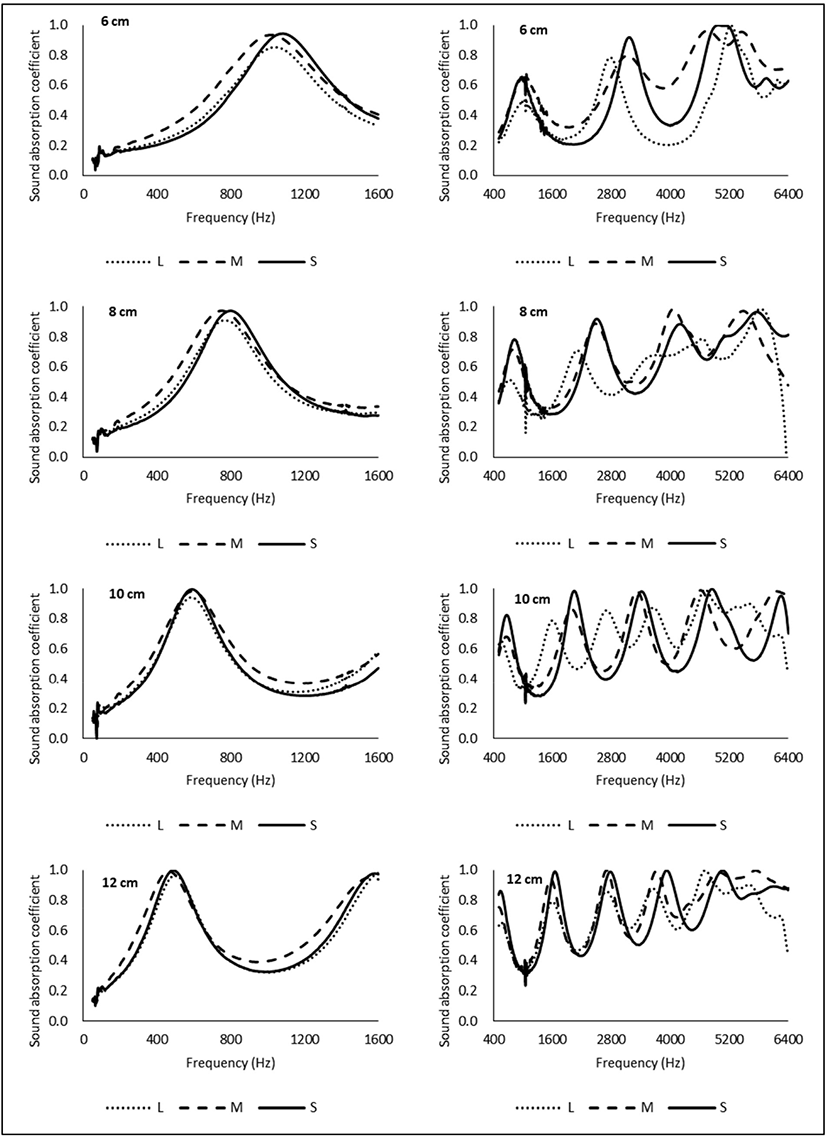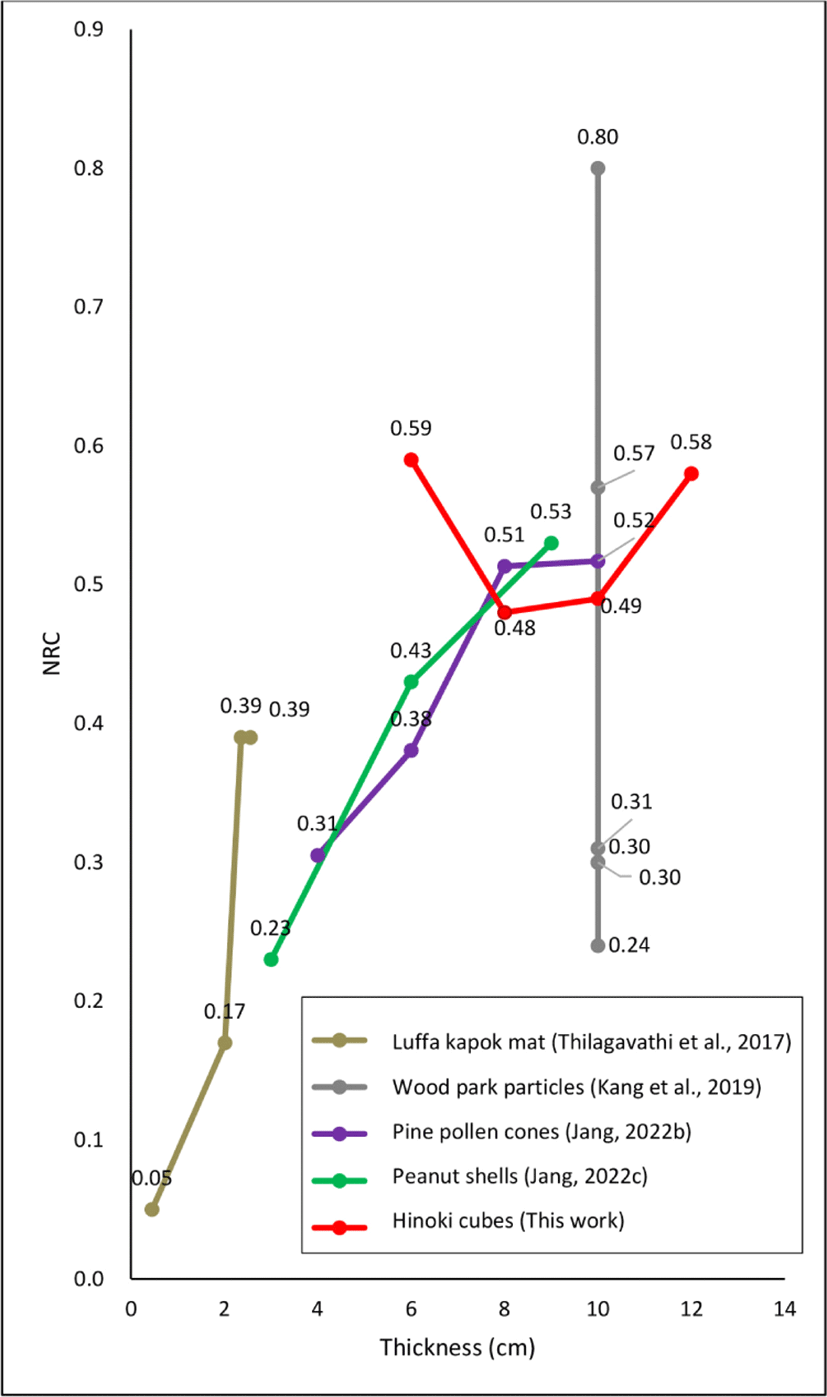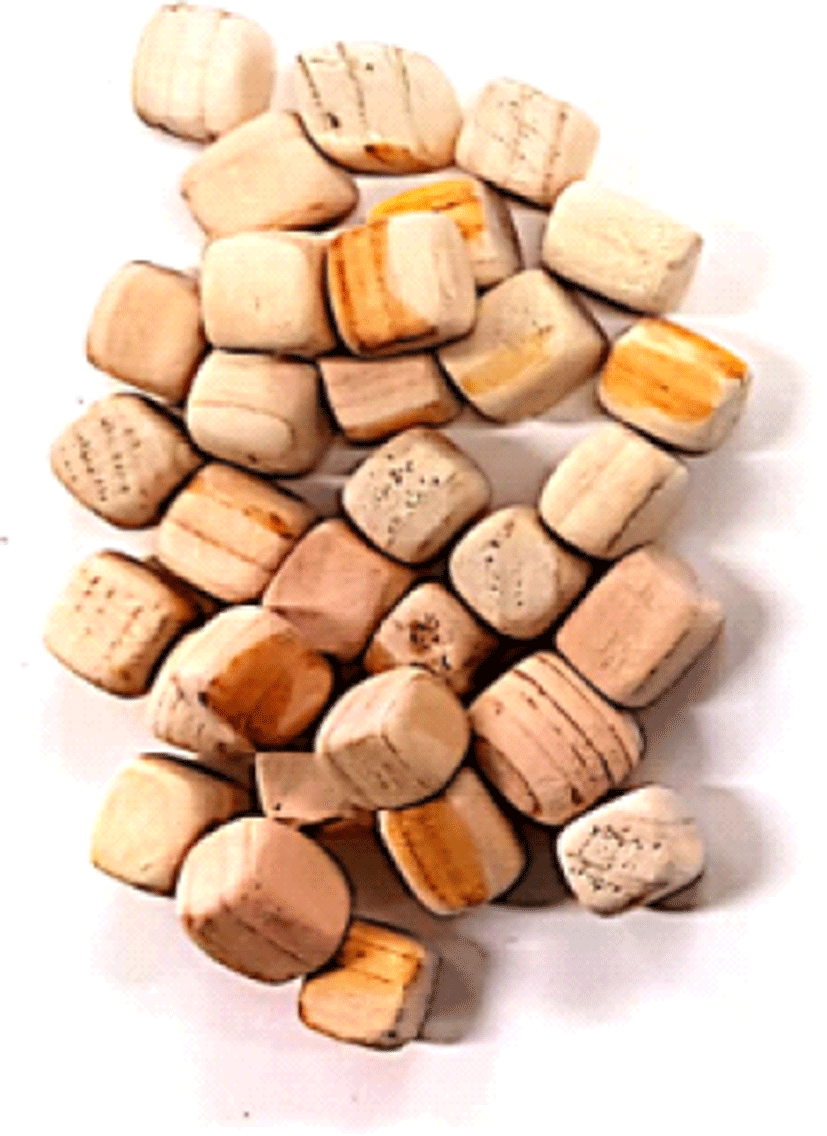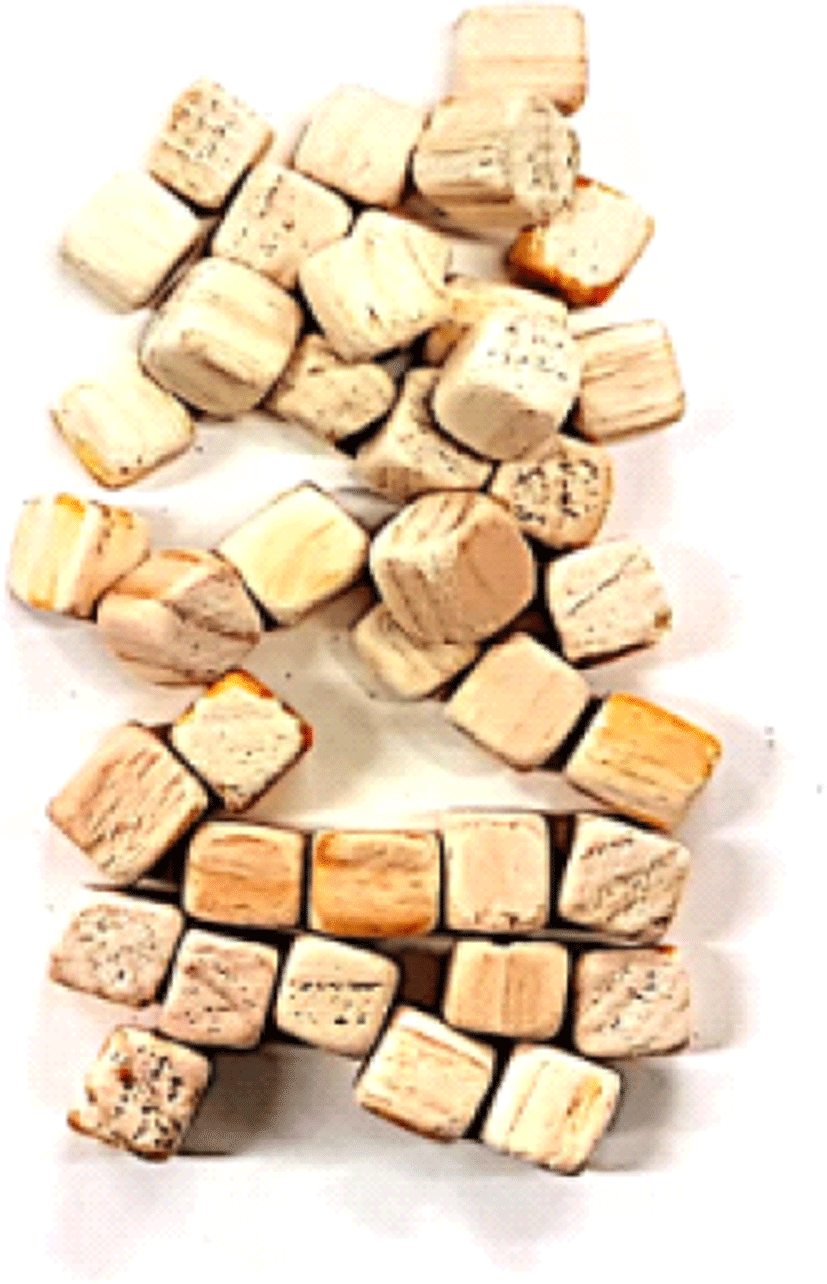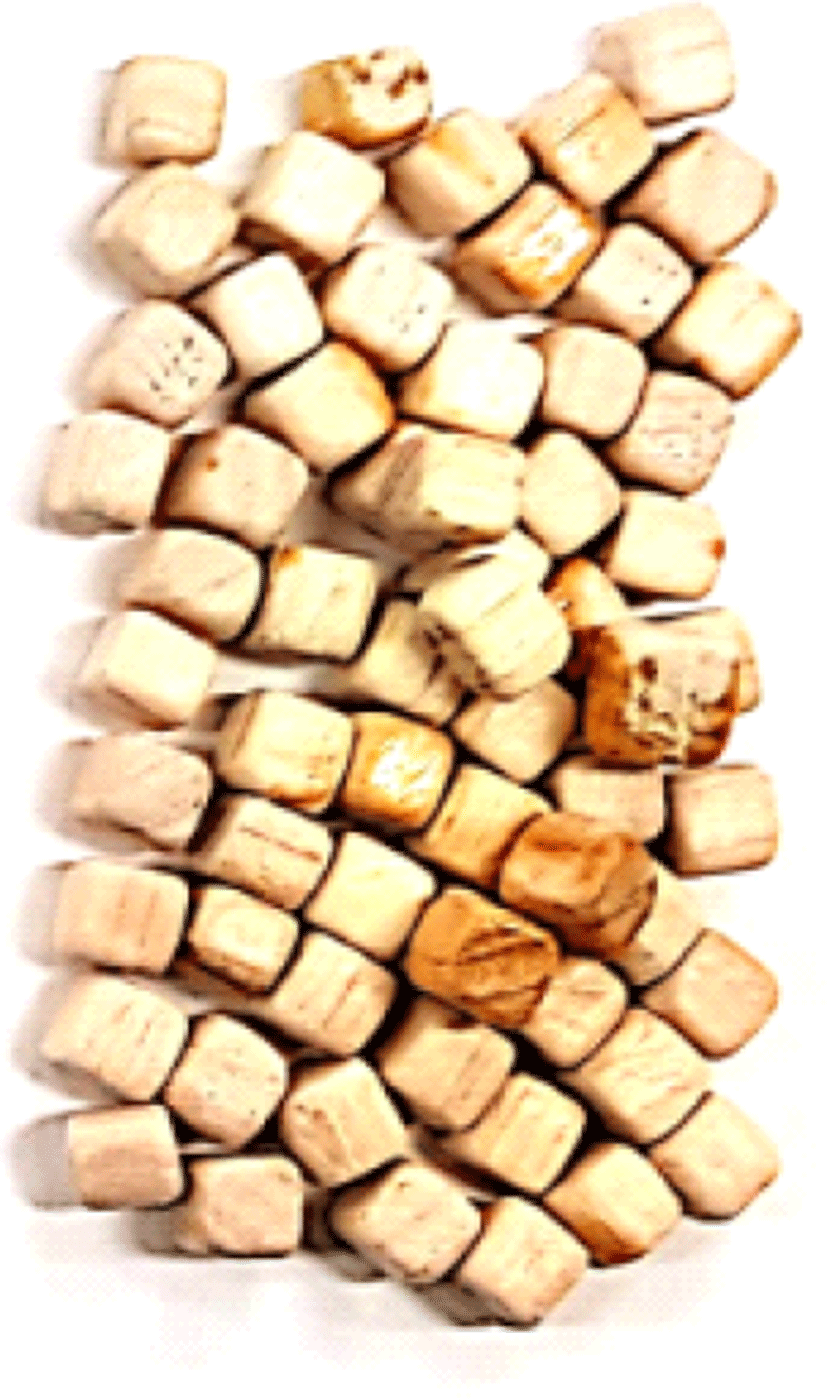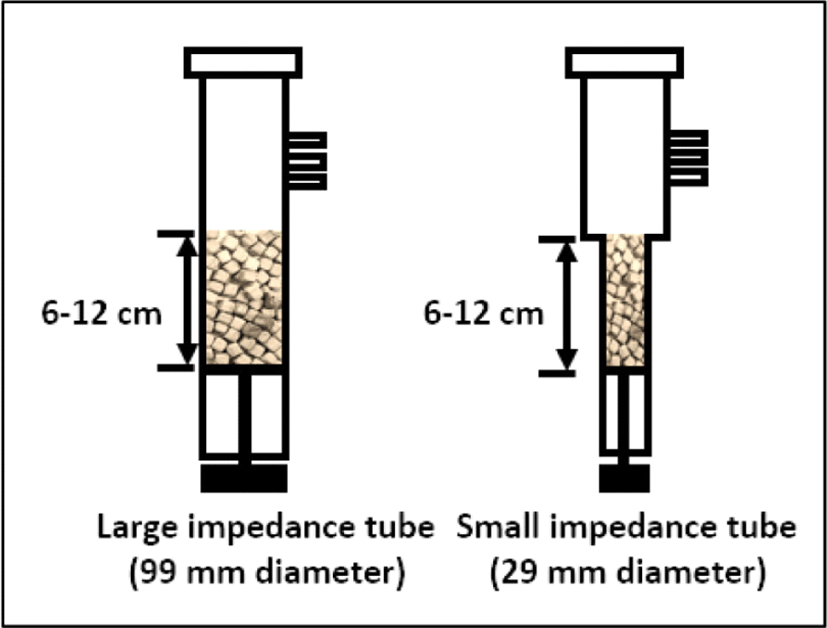Original Article
Investigation of Sound Absorption Ability of Hinoki Cypress (Chamaecyparis obtusa) Cubes
Eun-Suk JANG
1,2,†
1Research Institute of Human Ecology, College of Human Ecology, Jeonbuk National University, Jeonju 54896, Korea
2R&D Center, Sambo Scientific Co. Ltd., Seoul 07258, Korea
Copyright 2022 The Korean Society of Wood Science & Technology. This is an Open-Access article distributed under the terms of the
Creative Commons Attribution Non-Commercial License (http://creativecommons.org/licenses/by-nc/4.0/) which permits
unrestricted non-commercial use, distribution, and reproduction in any
medium, provided the original work is properly cited.
Received: Apr 27, 2022; Revised: Jul 06, 2022; Accepted: Sep 08, 2022
Published Online: Sep 25, 2022
ABSTRACT
Today, commercialized Hinoki cypress cubes are used for fragrance, humidification, and pillows in Korea. In this study, the sound absorption ability of Hinoki cypress (Chamaecyparis obtusa) cubes was examined. The three groups of Hinoki cypress cubes were prepared depending on their dimension (L: 9 × 9 × 9, M: 7 × 7 × 7, S: 4 × 4 × 4 mm). Their sound absorption coefficient was examined after filling 6, 8, 10, and 12 cm height in impedance tubes, respectively. Overall, the sound absorption ability depending on dimension was superior in the M group compared to the L and S groups. Also, as the filling height increased, the sound absorption capacity increased. In sum, noise reduction coefficients (NRC) of all Hinoki cypress cubes were 0.41–0.59. Thus, this research found that Hinoki cypress cubes have a sound-absorbing function.
Keywords: Hinoki cypress; Chamaecyparis obtusa; sound-absorbing material; sound absorption coefficient
1. INTRODUCTION
Trees grow by absorbing carbon dioxide from the atmosphere while alive and store carbon dioxide until is burned (Bellassen and Luyssaert, 2014). Accordingly, the United Nations Framework Convention on Climate Change (UNFCC) has also encouraged the use of wood products to reduce greenhouse gas emissions (Brunet-Navarro et al., 2018).
Wood is the most used eco-friendly material on the planet, with applications ranging from landscaping, building, and furniture (Dirna et al., 2020; Fujimoto et al., 2021; Hwang and Oh, 2022; Kim and Kim, 2021; Mokhirev et al., 2021; Park and Jo, 2020; Park et al., 2022; Schulz et al., 2021; Yang et al., 2020; Yun et al., 2021). Wood also improves indoor air quality by absorbing or releasing moisture from the air to maintain proper humidity and lowers stress by stabilizing humans emotionally (Lee et al., 2016).
Among variable wood species, the Hinoki cypress (Chamaecyparis obtusa) is a helpful tree for human health (Fujimoto et al., 2021; Kim et al., 2020; Park et al., 2020; Yang et al., 2019; Yeon et al., 2019). Li et al. (2009) reported an improvement in immune system function markers in subjects exposed to Hinoki cypress (Chamaecyparis obtusa) and Japanese cedar (Cryptomeria japonica). Ikei et al. (2018) reported that touching a cypress tree helps physiological relaxation by increasing parasympathetic nerve activity and calming the prefrontal cortex activity. Accordingly, several companies have commercialized Hinoki cypress cubes for fragrance, humidification, and pillows in Korea (Lee et al., 2017).
The author has focused on research on sound-absorbing materials using wood for building. Wood can be used as a resonant sound-absorbing material by perforated thin plate with an air back cavity (Peng et al., 2018). In addition, it can be used as a porous sound-absorbing material by using the pore structure of the cross-section of wood (Jang and Kang, 2021a, 2021b, 2021c, 2021d, 2021e, 2021f, 2022a, 2022c).
The wood’s pore structure and the void spaces between the cubes are suitable conditions for sound absorption. It is similar to a granular type sound-absorbing material (Arenas and Crocker, 2010; Jang, 2022a). Thus, this study intends to investigate that the Hinoki cypress (Chamaecyparis obtusa) not only has previously known fragrance and humidification effect, but also has a sound absorption function.
2. MATERIALS and METHODS
2.1. Sample preparation
Table 1 depicts the preparation of three types Hinoki cypress cubes depending on their dimensions used in this study. They were supplied from the Korean local wood market. The origin of the Hinoki cypress is the Republic of Korea. The surfaces of Hinoki cypress cubes appeared to have been polished smooth during manufacturing.
The bulk density of the cubes was calculated by weighing the cubes in a 500 mL beaker. Their skeletal density was measured from a gas pycnometer (PYC-100A-1, Porous Material, Ithaca, NY, USA), and the porosity was calculated according to Equation (1). The porosity includes both the open-pore porosity of the cube itself and the void space between the cubes.
where, ø is porosity (%), ρ is bulk density (g cm−3), and ρskeletal is skeletal density (g cm−3).
The moisture content (MC) was measured based on KS F 2199 (Korean Standards Association, 2016). The author calculated through weight difference after taking 100 g of samples from each group and placing them in a laboratory oven at 105°C for about seven days.
2.2. Scanning electron microscopy (SEM) image analysis
The surfaces of the Hinoki cypress cube were observed by the SEM (Genesis-1000, Gwangju, Emcraft, Korea) at 500 magnification. In wood anatomy, wood samples need to be smoothed and then shaved cleanly with a microtome to observe the pore structure of wood sections using SEM (Jang et al., 2018a). This pretreatment is essential to observe the pore structure of wood. However, the original Hinoki cypress cubes used in this study are not finished their surfaced with a microtome. So, their surfaces are totally different. Therefore, this study observed not only the surface of the Hinoki cypress cubes cut with a microtome but also the original sample surface. The original cypress cube has been polished on all sides. The surface polishing blocks the pores in the wood, which can disadvantage the sound absorption effect (Jang and Kang, 2022b).
2.3. Sound absorption coefficient of Hinoki cypress cubes
This study examined the sound absorption coefficient of Hinoki cypress cubes using an impedance tube (ISO 10534-2, 2001). The impedance tubes were type 4206 (Brüel & Kjær, Nærum, Denmark). They are divided into a large impedance tube with a diameter of 99 mm and a small impedance tube with a diameter of 29 mm depending on the frequency range (Fig. 1).
In this study, a large impedance tube was used for the frequency range of 100–1,600 Hz, and a small impedance tube was used for the frequency range of 500–6,400 Hz. The three types Hinoki cypress cubes were filled to a height of 6, 8, 10, and 12 cm in the both impedance tubes, respectively.
The noise reduction coefficient (NRC) is mainly used to evaluate the sound absorption performance as a single index (Kim and Lee, 2017). The NRC was calculated as in Equation (2).
where: α250: sound absorption coefficient at 250 Hz, α500: sound absorption coefficient at 500 Hz, α1000: sound absorption coefficient at 1,000 Hz, α2000: sound absorption coefficient at 2,000 Hz.
The sound absorption coefficients at 250, 500, and 1,000 Hz were obtained from a large impedance tube, and the sound absorption coefficient at 2,000 Hz was obtained from a small impedance tube. In addition, to evaluate the sound absorption ability for each frequency section, this study calculated average sound absorption coefficient at 250–500 and 500–1,000 from large impedance tube, and sound absorption coefficient at 1,000–2,000 and 2,000–6,400 Hz from small impedance tube.
All Hinoki cypress cubes were measured at an atmospheric pressure of 1,080.00 hPa, a temperature of 10.10°C, and a relative humidity of 32%. The sound velocity was 337.39 m/s, the air density was 1.250 kg/m3, and the characteristic impedance of air was 421.7 Pa/(m/s).
3. RESULTS and DISCUSSION
3.1. Scanning electron microscopy (SEM) images
Fig. 2 shows SEM images Hinoki cypress cube’s transverse and tangential planes. Fig. 2(a) and (b) show the transverse and tangential surface of Hinoki cypress shaved with a microtome, respectively, and Fig. 2(c) and (d) show the transverse and tangential planes of original Hinoki cypress cube, respectively.
Fig. 2.
SEM images of Hinoki cypress cube. (a) Transverse section shaved with a microtome, (b) tangential section shaved with a microtome, (c) transverse section without pretreatment, (d) tangential section without pretreatment. SEM: scanning electron microscopy.
Download Original Figure
Tracheids were observed in the transverse plane cut with a microtome (Jang et al., 2020). Their average diameter was 21.05 ± 2.75 (± is SD) μm. Tracheids and rays were observed in the tangential plane.
On the other hand, it was challenging to observe the anatomical features of the original Hinoki cypress cube. The transverse plane was observed as a rough surface, and the tangential plane was observed smooth surface. As a result, the Hinoki cypress cubes seemed challenging to utilize the wood’s pore structure for sound absorption.
3.2. Results of sound absorption coefficients
Fig. 3 shows the sound absorption curve of Hinoki cypress cubes depending on their filling height. The left side graphs are the sound absorption coefficient curves from the large impedance tube, and the right sides are the results from the small impedance tube.
Fig. 3.
Sound absorption curve of Hinoki cypress cubes depending on their filling height (left side: large impedance tube, right side: small impedance tube).
Download Original Figure
As the height of the cubes filled in the impedance tube increased, the sound absorption peak tended to move in the low-frequency direction. The sound absorption coefficients of the high-frequency region showed that the number of peaks increased as the height of the cubes filled in the impedance tube increased. This phenomenon is because as the height of the cubes increases, there is more space for the sound waves to penetrate, which is a typical sound absorption curve of a granular type sound absorbing material (Borrell et al., 2020).
Table 2 depicts the average sound absorption coefficient at each frequency range and NRCs of Hinoki tubes. At least, the results of this study showed that the Group (M) showed the optimum sound absorption performance when comparing the average sound absorption coefficient and NRC for each frequency section.
Table 2.
Average sound absorption coefficient at each frequency range and NRCs
Average Sound absorption coefficient
@ frequency range |
Group |
Filling height (cm) |
|
6 |
8 |
10 |
12 |
|
α
250–500
|
L |
0.22 |
0.32 |
0.51 |
0.68 |
|
M |
0.27 |
0.40 |
0.58 |
0.80 |
|
S |
0.20 |
0.29 |
0.51 |
0.71 |
|
α
500–1,000
|
L |
0.53 |
0.74 |
0.65 |
0.53 |
|
M |
0.64 |
0.82 |
0.72 |
0.55 |
|
S |
0.51 |
0.77 |
0.67 |
0.53 |
|
α
1,000–2,000
|
L |
0.33 |
0.38 |
0.39 |
0.57 |
|
M |
0.44 |
0.38 |
0.51 |
0.62 |
|
S |
0.34 |
0.36 |
0.44 |
0.61 |
|
α
2,000–6,400
|
L |
0.50 |
0.66 |
0.76 |
0.75 |
|
M |
0.71 |
0.73 |
0.73 |
0.81 |
|
S |
0.58 |
0.72 |
0.68 |
0.76 |
|
NRC |
L |
0.49 |
0.43 |
0.43 |
0.58 |
|
M |
0.59 |
0.48 |
0.49 |
0.58 |
|
S |
0.57 |
0.44 |
0.41 |
0.53 |
Download Excel Table
This seems to be related to the porosity of Hinoki cypress cubes. The porosity of Group (M) was 75.2%, which was larger than that of Group (L: 74.7%) and Group (S: 73.8%). Therefore, the sound absorption performance of Group (M) was superior to that of the other two groups because the space where the incident sound wave was dissipated was relatively large. Consequently, the void spaces between the cubes are suitable conditions for sound absorption.
According to ISO 11654 (1997), NRC grades are divided into 5 grades: below 0.10 is no grade, grade E is 0.15 to 0.25, grade D is 0.3 to 0.55, grade C is 0.60 to 0.75, grade B is 0.80 to 0.85, and grade A is 0.90 to 1.00 (Jang et al., 2018b; Kim and Lee, 2017). As a result of this study, all dimension of Hinoki cypress cubes show D grade, that it has a sound absorption function.
In this study, polished Hinoki cubes were used. The polished treatment hinders the sound absorption effect because it blocks the pores. If the cube cross-sections were not polished, the pores of the surface would have contributed to the improvement of the sound absorption performance (Jang and Kang, 2022b). As mentioned in the introduction section, the sound absorption performance is more likely to be better in hardwood species where vessels are developed (Jang and Kang, 2021a, 2021b, 2021c, 2021d, 2021e, 2021f, 2022a, 2022c). Thus, it is necessary to evaluate the sound absorption ability by making cubes of various hardwood species.
Fig. 4 compares the NRC of cypress cubes and natural materials investigated in previous studies (Jang, 2022b, 2022c; Kang et al., 2019; Thilagavathi et al., 2018). Most of the natural sound-absorbing material candidates presented in previous studies corresponded to grades E and D. Although the Hinoki cubes have the same D grade, the NRC showed a relatively high level compared to other natural sound-absorbing material candidates.
Fig. 4.
Sound absorption ability of Hinoki cypress cubes compared with previous studies. NRC: noise reduction coefficient.
Download Original Figure
This study was the first approach to evaluate the sound absorption ability of commercial Hinoki cypress cubes in Korea. It is expected that this study will contribute to diversifying the use of wood and further increase the added value of wood.
4. CONCLUSIONS
This study investigated the sound absorption performance of commercial Hinoki cypress cubes used as fragrance, humidification, and pillows in Korea. The results of this study are as follows.
As the filling heights of Hinoki cypress cubes increased, the sound absorption coefficient at low frequencies increased. In the high-frequency region, the number of sound absorption peaks increased as the filling heights increased. As a result of comparing the difference in sound absorption performance by the dimension of Hinoki cypress cubes, the sound absorption coefficient of the group (M) was superior to that of groups (L) and (S). Overall, the NRC of Hinoki cypress cubes was 0.41–0.59. In conclusion, it was found that Hinoki cypress cubes have a sound-absorbing function.
ACKNOWLEDGMENT
This research was supported by a grant from the Basic Science Research Program of the National Research Foundation of Korea (NRF), funded by the Ministry of Education (NRF-2019R1I1A3A02059471). It was also supported by a grant from the international cooperation program framework managed by the NRF (NRF-2020K2 A9A2A08000181). I am also thankful for the ‘‘Business Startup Incubator Support Program’’ supported by the Ministry of Education and the National Research Foundation of Korea.
REFERENCES
Arenas, J.P., Crocker, M.J. 2010. Recent trends in porous sound-absorbing materials. Sound and Vibration 44(7): 12-18.

Borrell, J.M.G., Sanchis, E.J., Alcaraz, J.S., Belda, I.M. 2020. Sustainable sound absorbers from fruit stones waste. Applied Acoustics 161: 107174.


Brunet-Navarro, P., Jochheim, H., Kroiher, F., Muys, B. 2018. Effect of cascade use on the carbon balance of the German and European wood sectors. Journal of Cleaner Production 170: 137-146.


Dirna, F.C., Rahayu, I., Zaini, L.H., Darmawan, W., Prihatini, E. 2020. Improvement of fast-growing wood species characteristics by MEG and nano SiO
2 impregnation. Journal of the Korean Wood Science and Technology 48(1): 41-49.


Fujimoto, Y., Tanaka, H., Morita, H., Kang, S.G. 2021. Development of ply-lam composed of Japanese cypress laminae and Korean larch plywood. Journal of the Korean Wood Science and Technology 49(1): 57-66.


Hwang, J.W., Oh, S.W. 2022. Formaldehyde deodorization effect and far-infrared emission characteristics of ceramics prepared with sawdust, risk husk, and charcoal: Effect of material mixing ratio. Journal of the Korean Wood Science and Technology 50(2): 104-112.


Ikei, H., Song, C., Miyazaki, Y. 2018. Physiological effects of touching Hinoki cypress (
Chamaecyparis obtusa). Journal of Wood Science 64(3): 226-236.


ISO 10534-2. 2001. Acoustics-Determination of Sound Absorption Coefficient and Impedance in Impedance Tubes-Part 2 Transfer-function Method. International Organization for Standardization (ISO), Geneva, Switzerland.

ISO 11654. 1997. Acoustics — Sound Absorbers for Use in Buildings — Rating of Sound Absorption. International Organization for Standardization (ISO), Geneva, Switzerland.

Jang, E.S. 2022a. Experimental investigation of the sound absorption capability of wood pellets as an eco-friendly material. Journal of the Korean Wood Science and Technology 50(2): 126-133.


Jang, E.S. 2022b. Peanut shells as an environmentally beneficial sound-absorbing material. Journal of the Korean Wood Science and Technology 50(3): 179-185.


Jang, E.S. 2022c. Use of pine (
Pinus densiflora) pollen cones as an environmentally friendly sound-absorbing material. Journal of the Korean Wood Science and Technology 50(3): 186-192.


Jang, E.S., Kang, C.W. 2021a. Delignification effects on Indonesian Momala (
Homalium foetidum) and Korean Red Toon (
Toona sinensis) hardwood pore structure and sound absorption capabilities. Materials 14(18): 5215.




Jang, E.S., Kang, C.W. 2021b. Effect of porous traits of hardwoods cross-section on sound absorption performance -Focus on 6 species of Korean hardwoods. Wood and Fiber Science 53(4): 260-272.


Jang, E.S., Kang, C.W. 2021c. Investigation of sound absorption properties of heat-treated Indonesian Momala (
Homalium foetidum (Roxb.) Benth.) and Korean Red Toon (
Toona sinensis (A. Juss.) M. Roem.) cross sections. Forests 12(11): 1447.


Jang, E.S., Kang, C.W. 2021d. The pore structure and sound absorption capabilities of
Homalium (
Homalium foetidum) and jelutong (
Dyera costulata). Wood Science and Technology 56(1): 323-344.


Jang, E.S., Kang, C.W. 2021e. Sound absorption characteristics of three species (binuang, balsa and paulownia) of low density hardwood. Holzforschung 75(12): 1115-1124.


Jang, E.S., Kang, C.W. 2021f. The use of ring-porous East Asian ash (
Fraxinus japonica (Thunb.) Steud.) and oak (
Quercus spp.) cross-sections as eco-friendly resonance-absorbing materials for building. Wood Material Science & Engineering.


Jang, E.S., Kang, C.W. 2022a. Change in sound absorption capability on thermally modified transverse and radial planes of Indonesian
Homalium foetidum. BioResources 17(3): 5234-5242.


Jang, E.S., Kang, C.W. 2022b. Influence of surface finishing of hardwood cross-section on sound absorption performance. BioResources 17(2): 2874-2883.


Jang, E.S., Kang, C.W. 2022c. Why the sound-absorbing performance of heartwood and sapwood differs in yellow poplar (
Liriodendron tulipifera) cross-sections? Wood Research 67(3): 372-382.


Jang, E.S., Kang, C.W., Jang, S.S. 2018a. Comparison of the Mercury intrusion porosimerty, capillary flow porometry and gas permeability of eleven species of Korean wood. Journal of the Korean Wood Science and Technology 46(6): 681-691.


Jang, E.S., Kang, C.W., Kang, H.Y., Jang, S.S. 2018b. Sound absorption property of traditional Korean natural wallpaper (Hanji). Journal of the Korean Wood Science and Technology 46(6): 703-712.


Jang, E.S., Yuk, J.H., Kang, C.W. 2020. An experimental study on change of gas permeability depending on pore structures in three species (Hinoki, Douglas fir, and Hemlock) of softwood. Journal of Wood Science 66(1): 78.


Kang, C.W., Jang, E.S., Jang, S.S., Kang, H.Y., Kang, S.G., Oh, S.C. 2019. Sound absorption rate and sound transmission loss of wood bark particle. Journal of the Korean Wood Science and Technology 47(4): 425-441.


Kim, J.G., Kang, S.G., Mostafiz, M.M., Lee, J.M., Lee, K.Y., Hwang, T.K., Lim, J.T., Kim, S.Y., Lee, W.H. 2020. Insect repellency and crop productivity of essential oil films. Journal of the Korean Wood Science and Technology 48(1): 95-106.


Kim, J.Y., Kim, B.R. 2021. Hygroscopicity and ultraviolet (UV) deterioration characteristics of finished woods. Journal of the Korean Wood Science and Technology 49(5): 471-481.


Kim, Y., Lee, S. 2017. Sound absorption performance of noise barrier according to single number rating methods. Transactions of the Korean Society for Noise and Vibration Engineering 27(2): 243-250.


Korean Standards Association. 2016. Determination of Moisture Content of Wood. KS F 2199. Korean Standards Association, Seoul, Korea.

Lee, M., Park, S.B., Lee, S.M. 2016. Comparison of moisture absorption/desorption properties of carbonized boards made from wood-based panels. Journal of the Korean Wood Science and Technology 44(3): 424-429.


Lee, S.H., Lee, Y.J., Oh, J.H., Jang, C.S., Hong, S.M. 2017. An Activation Research on the 6th Industrialization of Forestry. Gyeonggi Research Institute, Suwon, Korea.

Li, Q., Kobayashi, M., Wakayama, Y., Inagaki, H., Katsumata, M., Hirata, Y., Hirata, K., Shimizu, T., Kawada, T., Park, B.J., Ohira, T., Kagawa T., Miyazaki, Y. 2009. Effect of phytoncide from trees on human natural killer cell function. International Journal of Immunopathology and Pharmacology 22 (4): 951-959.



Mokhirev, A., Rukomojnikov, K., Gerasimova, M., Medvedev, S. 2021. Design of logging infrastructure in consideration of the dynamically changing environment. Journal of the Korean Wood Science and Technology 49(3): 254-266.


Park, H.J., Jo, S.U. 2020. Evaluation of physical, mechanical properties and pollutant emissions of wood-magnesium laminated board (WML board) for interior finishing materials. Journal of the Korean Wood Science and Technology 48(1): 86-94.


Park, K.C., Kim, B., Park, H., Park, S.Y. 2022. Peracetic acid treatment as an effective method to protect wood discoloration by UV light. Journal of the Korean Wood Science and Technology 50(4): 283-298.


Park, S., Han, Y., Son, D.W. 2020. Flame retardancy of wood products by spreading concentration and impregnation time of flame retardant. Journal of the Korean Wood Science and Technology 48(4): 417-430.


Peng, L., Liu, M., Wang, D., Song, B. 2018. Sound absorption properties of wooden perforated plates. Wood Research 63(4): 559-572.

Schulz, H.R., Acosta, A.P., Barbosa, K.T., Junior, M.A.P.S., Gallio, E., Delucis, R.Á., Gatto, D.A. 2021. Chemical, mechanical, thermal, and colorimetric features of the thermally treated
Eucalyptus grandis wood planted in Brazil. Journal of the Korean Wood Science and Technology 49(3): 226-233.


Thilagavathi, G., Neela Krishnan, S., Muthukumar, N., Krishnan, S. 2018. Investigations on sound absorption properties of luffa fibrous mats. Journal of Natural Fibers 15(3): 445-451.


Yang, J., Choi, W.S., Kim, J.W., Lee, S.S., Park, M.J. 2019. Anti-inflammatory effect of essential oils extracted from wood of four coniferous tree species. Journal of the Korean Wood Science and Technology 47(6): 674-691.


Yang, S.M., Lee, H.J., Kang, S.G. 2020. Analysis of heat transfer characteristics by materials in closed conditions using acrylic hemisphere (I): Comparison of interior finishing materials. Journal of the Korean Wood Science and Technology 48(2): 217-230.


Yeon, S., Park, S.Y., Kim, J.H., Kim, J.C., Yang, S.Y., Yeo, H., Kwon, O., Choi, I.G. 2019. Effect of organic solvent extractives on Korean softwoods classification using near-infrared spectroscopy. Journal of the Korean Wood Science and Technology 47(4): 509-518.


Yun, J., Shin, H.C., Hwang, W.J., Yoon, S.M., Kim, Y.S. 2021. Identification of sapstain fungi on weathered wooden surfaces of buildings at Jangheung and Jeju Island. Journal of the Korean Wood Science and Technology 49(6): 591-601.


